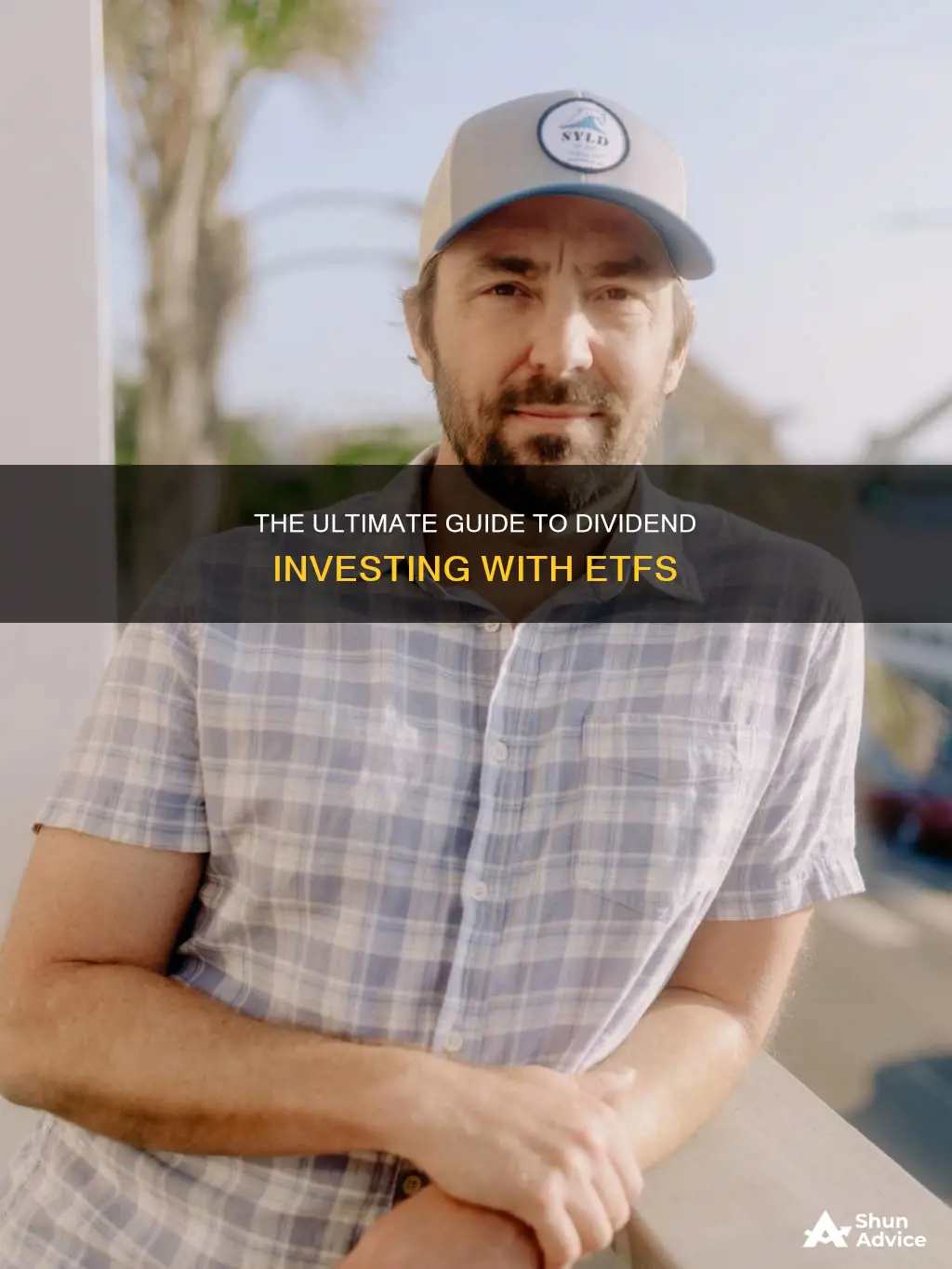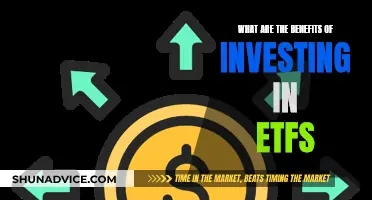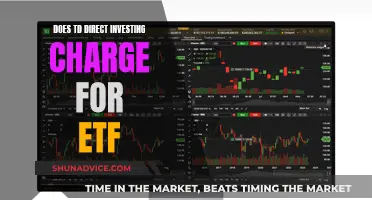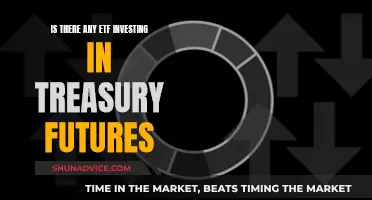
Dividend investing is a strategy that focuses on investing in stocks that pay out dividends, or a share of a company's profits, to their investors. Dividend investing is a way to generate a steady stream of income, and investors can either choose to pad their income with these dividends or reinvest them back into the fund to take advantage of compound interest and grow their investment portfolio. A dividend exchange-traded fund (ETF) is a fund that invests exclusively in dividend-paying companies, and they are a great option for investors who want to increase cash flow and diversify their investments. Dividend ETFs are passively managed, meaning they track a specific index, but the index is usually screened to include companies with a strong history of dividend increases. They are also good investment options for investors who are risk-averse and income-seeking.
| Characteristics | Values |
|---|---|
| Definition | A dividend ETF is an exchange-traded fund (ETF) designed to invest in a basket of dividend-paying stocks. |
| How it works | The fund manager will choose a portfolio of stocks, based on a dividend index, that pays out dividends to investors, thereby working as an income-investing strategy. |
| Types of dividends | There are two basic types of dividends issued to investors of ETFs: qualified and non-qualified dividends. |
| Taxation | Dividends may be taxed at the long-term capital gains rate or the investor's ordinary income tax rate. |
| Reinvestment | Dividends can be reinvested in the ETF rather than distributed as cash. |
| Risk | Dividend ETFs are good investment options for investors that are risk-averse and income-seeking. |
What You'll Learn

Dividend ETF explained
A dividend ETF, or exchange-traded fund, is a fund that invests in a basket of dividend-paying stocks. The fund manager will choose a portfolio of stocks that pay out dividends to investors, based on a dividend index. Dividend ETFs are passively managed, meaning they track a specific index and the fund manager does not have to make frequent trading decisions.
How Dividend ETFs Work
Dividend ETFs are established to gain high yields when investing in high-dividend-paying common stocks, preferred stocks, or real estate investment trusts (REITs). They may contain only domestic stocks or be global dividend ETFs with an international focus. Most indexes used to create dividend ETFs hold stocks with above-market dividend yields and higher liquidity than average.
The fund manager will receive the dividend distribution and pass it to investors, usually quarterly and often with the option to reinvest the dividend to acquire more shares. Dividend ETFs are a good option for investors who are risk-averse and income-seeking.
Types of Dividends
There are two basic types of dividends issued to investors of ETFs: qualified and non-qualified dividends. Qualified dividends are taxed at the capital gains rate, which depends on the investor's modified adjusted gross income (MAGI) and taxable income rate. Non-qualified dividends are taxed at the investor's ordinary income tax rate and are commonly paid on stocks held by the ETF for 60 days or less.
Examples of Dividend-Paying ETFs
Some popular dividend-focused ETFs include:
- SPDR S&P Dividend ETF (SDY)
- Vanguard Dividend Appreciation ETF (VIG)
- IShares Select Dividend ETF (DVY)
- IShares Core High Dividend ETF (HDV)
- Vanguard High Dividend Yield ETF (VYM)
Factors to Consider When Choosing a Dividend ETF
When choosing a dividend ETF, it is important to consider the expense ratio, dividend yield, track record of returns, and the fund's holdings. It is also crucial to determine your financial goals, research dividend funds, outline your asset mix, and periodically review your investments.
Infrastructure ETFs: Smart Investment or Risky Business?
You may want to see also

Dividend ETFs vs. Other ETFs
Dividend ETFs are a type of exchange-traded fund (ETF) that focuses on investing in dividend-paying stocks. They are designed to provide a steady income stream to investors and are passively managed, meaning the fund manager follows an index rather than actively making trading decisions. Dividend ETFs are suitable for investors who are risk-averse and seeking regular income. They offer broad exposure to many stocks within a given index and have low costs due to their low expense ratios.
Other types of ETFs include:
- IPO ETFs: These ETFs invest in initial public offerings (IPOs) during their market introduction, offering potential upside growth but no guarantee of long-term stability.
- Index ETFs: These ETFs track a benchmark index like the S&P 500 as closely as possible, providing exposure to a variety of securities in one transaction.
- ETF of ETFs: This type of ETF tracks other ETFs instead of underlying stocks or indices, allowing for more diversification and the inclusion of variables such as risk levels and time horizons.
When comparing dividend ETFs with other types of ETFs, it's important to consider factors such as investment goals, risk tolerance, and diversification needs. Dividend ETFs offer a consistent income stream and are generally more stable, making them attractive for retirees or risk-averse investors. Other ETFs, like IPO ETFs, may provide more growth potential but with less stability. Ultimately, the choice depends on the investor's financial goals, risk appetite, and investment strategy.
Diversifying Your Portfolio: Exploring the Right Number of ETFs
You may want to see also

How to invest in dividend ETFs
Dividend ETFs are a great investment option for those looking for income and diversification. They are also suitable for investors who are risk-averse. Here is a step-by-step guide on how to invest in dividend ETFs:
Step 1: Understand Dividend ETFs
Dividend ETFs are exchange-traded funds (ETFs) that are designed to invest in a basket of dividend-paying stocks. The fund manager chooses a portfolio of stocks that pay out dividends to investors, based on a dividend index. Dividend ETFs are passively managed, meaning they track a specific index and the fund manager does not have to make frequent trading decisions. Dividend ETFs can contain only US domestic stocks or they can be global dividend ETFs with an international focus.
Step 2: Know the Types of Dividends
There are two basic types of dividends issued to investors of ETFs: qualified and non-qualified dividends. Qualified dividends are taxed at the capital gains rate, which depends on the investor's modified adjusted gross income (MAGI) and taxable income rate. Non-qualified dividends are taxed at the investor's ordinary income tax rate and are usually paid on stocks held by the ETF for 60 days or less.
Step 3: Research and Choose a Dividend ETF
When choosing a dividend ETF, consider the following factors:
- Dividend yield: This is the percentage of the purchase price paid in dividends during the previous 12 months.
- Dividend growth: Look for ETFs with a strong history of dividend growth over time.
- Dividend quality: Consider the quality and creditworthiness of the stocks owned by the ETF. Avoid funds that use riskier companies with lower credit ratings.
- Expense ratio: Look for ETFs with a low expense ratio, typically under 0.50%.
- Assets under management (AUM): This gives an indication of the fund's size and stability.
- Stock size and sector allocation: Dividend ETFs can be invested in companies with large, medium, or small market capitalizations, and different sectors may offer higher yields.
Some popular dividend ETFs include:
- Vanguard Dividend Appreciation ETF (VIG)
- Schwab US Dividend Equity ETF (SCHD)
- Vanguard High Dividend Yield ETF (VYM)
- IShares International Select Dividend ETF (IDV)
- Invesco KBW Premium Yield Equity REIT ETF
- Fidelity High Dividend ETF (FDVV)
Step 4: Buy the Dividend ETF
You can buy dividend ETFs through an online broker, just like you would buy a stock. Consider buying them regularly to take advantage of dollar-cost averaging.
A Beginner's Guide to Silver ETF Investing
You may want to see also

Are dividend ETFs a good investment?
Dividend ETFs are a good investment option for investors who are risk-averse and income-seeking. They are exchange-traded funds (ETFs) that invest in a basket of dividend-paying stocks, providing investors with an income-investing strategy. The fund manager chooses a portfolio of stocks based on a dividend index, which pays out dividends to investors. Dividend ETFs are passively managed, meaning they track a specific index and the fund manager does not have to make frequent trading decisions.
Dividend ETFs offer high yields when investing in high-dividend-paying common stocks, preferred stocks, or real estate investment trusts (REITs). They can contain only US domestic stocks or be global dividend ETFs with an international focus. Most indexes used to create dividend ETFs hold stocks with above-market dividend yields and higher liquidity.
Dividend ETFs are a convenient way to pursue income investing without the need to own and manage a basket of individual dividend stocks. They offer diversification, broad market exposure, and low costs due to their low expense ratios. They are also traded on exchanges, making it easy to buy and sell them. Additionally, the investment companies that manage dividend ETFs provide transparency by disclosing their holdings daily.
However, it is important to note that dividend ETFs are not risk-free. They can be affected by market volatility and other factors, and companies can reduce or suspend dividend payments at any time, impacting the ETF's performance. When considering dividend ETFs, investors should be aware of the dividend yield, dividend growth, and dividend quality to make an informed decision.
Overall, dividend ETFs are a good investment option for those seeking income and diversification, but it is crucial to understand the risks and conduct thorough research before investing.
A Beginner's Guide to Investing in ICICI Silver ETF
You may want to see also

What to look for in a dividend ETF
Dividend ETFs are a great way to gain exposure to a basket of dividend-paying stocks, providing diversification and income. When choosing a dividend ETF, there are several key factors to consider:
- Expense Ratio: Look for ETFs with low expense ratios, as these fees can eat into your investment returns. Aim for an expense ratio of under 0.50%, but remember that lower is better.
- Dividend Yield: Understand the expected income by examining the dividend yield, which is the percentage of the share price paid out as dividends. Keep in mind that future dividends are not guaranteed.
- Track Record of Returns: While a high yield is attractive, also consider the fund's historical performance to ensure it is not consistently declining in value.
- Diversification: Check the fund's holdings to ensure it is not overly concentrated in specific companies or industries. Diversification reduces risk and provides a broader range of exposure.
- Assets Under Management (AUM): Consider the fund's AUM, as very high dividends coupled with low AUM could indicate a risky investment.
- Dividend History: Look for ETFs with a strong track record of consistent dividend payments and, ideally, a history of increasing dividend payouts over time.
- Investment Style: Different dividend ETFs have different investment styles, such as focusing on large-cap, mid-cap, or small-cap companies. Choose an ETF that aligns with your risk tolerance and investment objectives.
- Top Holdings: Review the ETF's top holdings to understand the specific companies it invests in and their financial stability.
- Performance: Evaluate the fund's historical performance, including 5-year returns, to get a sense of how it has fared over time.
- Risk Profile: Understand the risk profile of the ETF, considering the types of assets it invests in and the potential impact of macroeconomic factors.
The Ultimate Guide to Trading Investment ETFs
You may want to see also
Frequently asked questions
A dividend ETF is an exchange-traded fund (ETF) that invests in a basket of dividend-paying stocks. The fund manager will choose a portfolio of stocks, based on a dividend index, that pays out dividends to investors, working as an income-investing strategy.
Dividends are paid to the ETF issuer, which then pays them on to investors in proportion to the number of shares they hold. Dividends may be paid in cash or reinvested in the fund.
Dividends are usually paid quarterly, but this can vary depending on the ETF.
Dividends are taxed at the long-term capital gains rate or the investor's ordinary income tax rate.







